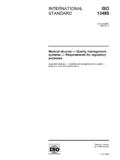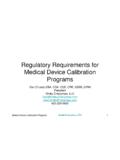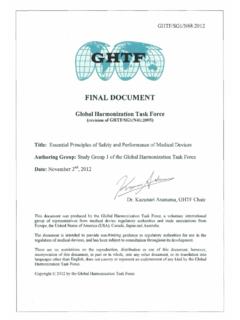Transcription of Dregs Couverture der - WHO
1 HEALTHCARE TECHNOLOGY LIFE CYCLE medical DEVICE. Marketing Transfer Distribution Manufacture Testing Development Research PROVISION. regulations . Assessment of needs Global overview and Technology assessment Evaluation Planning De-commissioning guiding principles Maintenance Procurement Training Installation Operation ACQUISITION Commissioning UTILISATION. DEPARTMENT OF BLOOD SAFETY AND CLINICAL TECHNOLOGY. WORLD HEALTH ORGANIZATION. 1211 GENEVA 27 92 4 154618 2. SWITZERLAND. Fax 41 22 791 4836. E-mail WORLD HEALTH ORGANIZATION. GENEVA. medical DEVICE. regulations . Global overview and guiding principles WORLD HEALTH ORGANIZATION. GENEVA. WHO Library Cataloguing-in-Publication Data World Health Organization. medical device regulations : global overview and guiding principles. and supplies legislation and supplies . standards making management control ISBN 92 4 154618 2 (NLM Classification: WA 26). Acknowledgements This guide was prepared under the principal authorship of Dr Michael Cheng.
2 It is based on a similar publication issued by the Pan American Health Organization (PAHO) in 1999 that reviewed the Canadian medical devices regulatory System. The comments and suggestions made by members of the Global Harmonization Task Force and those of many other reviewers are gratefully acknowledged. The Department of Blood Safety and Clinical Technology thanks the Governments of Italy and Luxembourg for their continued support to its work on medical devices . World Health Organization 2003. All rights reserved. The designations employed and the presentation of the material in this publication do not imply the expression of any opinion whatsoever on the part of the World Health Organization concerning the legal status of any country, territory, city or area or of its authorities, or concerning the delimitation of its frontiers or boundaries. The mention of specific organizations, companies or products does not imply that they are endorsed or recommended by the World Health Organization in preference to others of a similar nature that are not mentioned.
3 Errors and omissions excepted, the names of proprietary products are distinguished by initial capital letters. Neither the World Health Organization nor the principal author warrant that the information contained in this publication is complete and correct and shall not be liable for any damages incurred as a result of its use. Publications of the World Health Organization can be obtained from Marketing and Dissemination, World Health Organization, 20 Avenue Appia, 1211 Geneva 27, Switzerland (Fax: +41 22 791 4857; email: Requests for permission to reproduce or translate WHO publications whether for sale or for noncommercial distribution should be addressed to Publications, at the above address (fax: +41. 22 791 4806; email: Designed by minimum graphics Printed in France Contents Foreword v Glossary vii Note on the definition of medical devices vii Chapter 1. Introduction 1. Chapter 2. medical device safety 3. medical device safety and risk management 3.))
4 Effectiveness/performance of medical devices 4. Phases in the life span of a medical device 5. Participants in ensuring the safety of medical devices 6. The role of each participant/stakeholder 7. Shared responsibility for medical device safety and performance 8. Chapter 3. Governmental regulation of medical devices 9. Critical elements for regulatory attention 9. Stages of regulatory control 10. A common framework for medical device regulations 10. regulatory tools and general requirements 11. Product control 11. Vendor establishment control 12. Post-market surveillance/vigilance 12. Quality system requirements 13. Chapter 4. Global Harmonization Task Force (GHTF) 15. Objectives 15. Scope of the four GHTF study groups 15. Benefits of the GHTF 16. Final documents from the GHTF 17. Global medical Device Nomenclature (GMDN) 17. Chapter 5. Standards 18. What are standards? 18. Why do we need standards? 19. Voluntary and mandatory standards 19. Standards development process 20.
5 Conformity assessment with standards 20. National and international standards systems 21. Identification of standards 21. Current trends in the use of standards in medical device regulations 22. Chapter 6. Optimizing the use of regulatory resources 24. Increasing knowledge of the medical device sector 24. iii Establishing basic regulatory programmes 25. Basic legislation 25. Sharing problem reports 25. Drafting a comprehensive policy or guideline on medical device management 26. Advantages of a national policy 26. Classification of medical devices 26. medical device product control 27. Product representation control 27. Vendor establishment control 28. The control of home-use, refurbished, and donated devices 28. The re-use of medical devices that are labelled for single use 29. Post-market surveillance 30. Recognition and use of established national or international standards 31. Promoting compliance and cooperation 31. Setting priorities for regulatory programme development 32.
6 Cautions in interpreting medical device export certificates 34. Chapter 7. Priorities on the international agenda 36. Annex 1. Resources for medical device information 37. Annex 2. Final documents of the GHTF as they relate to the Common regulatory Framework 40. Annex 3. Relationship between ISO9001:1994 and ISO13485:1996 41. Annex 4. Aide-m moire for National medical Device Administrations 42. iv medical DEVICE regulations . Foreword The term medical devices covers a vast range of equipment, from simple tongue depressors to haemodialysis machines. Like medicines and other health technologies, they are essential for patient care at the bedside, at the rural health clinic or at the large, specialized hospital. medical devices also cost governments a substantial amount of money. In 2000, the estimated one and a half million different medical devices available on the market represented over US$145 billion. With innovation and the rapid advancement of technologies, medical devices are currently one of the fastest growing industries, and the global market figure for 2006 is expected to exceed US$260 billion.
7 Yet many countries lack access to high-quality devices and equipment that are appropriate for their specific epidemiological needs. This is particularly true in developing countries, where health technology assessments are rare and where little regulatory controls exist to prevent the importation or use of substandard devices . With the vast majority of devices in developing countries being imported, this leaves them prey to unscrupulous market influences and puts patients' lives at risk. Governments need to put in place policies that will address all elements related to medical devices , ranging from access to high quality, affordable products, through to their safe and appropriate use and disposal. The health technology life cycle diagram (back cover) illustrates the policy process that needs to be in place. However, policies will be unsuccessful unless they are translated into national regulations that are enforced by legislation and correlating sanctions, and that form an integral part of the overall national health system.
8 Surprisingly, regulatory controls for medical devices are scarce in the developing world, even though implementation of national medical device regulations will often address the very issues raised in countries as major concerns for patient safety. Examples of these issues include the illegal re-processing and re-packaging of used syringes for re-sale; the availability on the market of equipment that fails minimum quality and safety standards;. or simply no trace of what devices are being sold in the country, nor by whom. Such a listing is essential to enable governments to issue alerts or recalls for unsafe or ineffective items. The purpose of this publication is to provide guidance to Member States wishing to create or modify their own regulatory systems for medical devices . It is recognized that there is no single template that will respond to the needs of every country. Some countries may have production facilities that will require good manufacturing practice and complex quality controls; others may depend principally on the donation of equipment from external sources and need different policies to protect their population against unsafe and inappropriate technology.
9 Resources, both human and financial, remain a significant factor in the progressive development of national regulatory authorities. Nevertheless, there are many ways that governments can benefit from the wealth of experience of others, and v start to build efficient medical device regulatory systems. This publication highlights the most important of these. In essence, governments are encouraged to follow the growing movement towards harmonized regulatory systems because a proliferation of different national regulations increases costs, hinders access to health care technologies, and can even unwittingly jeopardize the safety of the patient. Secondly, Member States can adopt where appropriate the device approvals of the advanced regulatory systems, since this process represents a vast, and often unnecessary drain on scarce resources. This will allow countries with weak regulatory systems to place emphasis and initial resources on areas such as vendor and device registration, training, and surveillance and information exchange systems on the assessment of medical devices in use.
10 WHO is reinforcing its role in providing technical support to Member States who wish to implement improved medical device regulatory systems. We hope that this guide provides a useful framework within which countries can assess and address their needs to protect their populations from the risks of unsafe technology. Dr Vladimir K. Lepakhin Assistant Director-General Health Technology and Pharmaceuticals vi medical DEVICE regulations . Glossary Note on the definition of medical devices The term medical devices includes everything from highly sophisticated computerized medical equipment down to simple wooden tongue depressors. The intended primary mode of action of a medical device on the human body, in contrast with that of medicinal products, is not metabolic, immunological, or pharmacological. Several different international classification systems for medical devices are still in use in the world today. The World Health Organization, with its partners, is working towards achieving harmonization in medical device nomenclature, which will have a significant impact on patient safety (see section ).
















